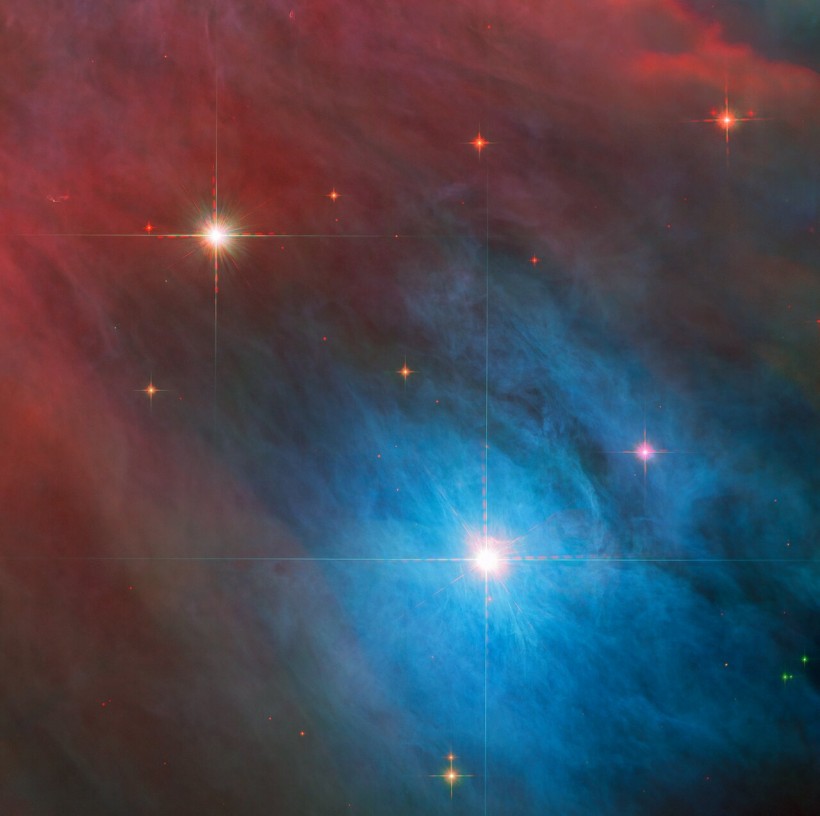NASA/ESA's Hubble Space Telescope (HST) took an image of tempestuous newborn stars in the Orion Nebula, which is shared in ESA's website. The bigger of the two very brilliant stars with cross-shaped diffraction spike is a little lower-right of the center, while the smaller is in the upper-left corner. Around them are little red stars with brief diffraction spikes.
The backdrop is nearly totally obscured by gas: hazy, vivid blue gas surrounding the bigger star in the center and lower-right, and wispier red gas elsewhere.
The image combines data from two Hubble Space Telescope sensors. Infrared and visible wavelength data from the Advanced Camera for Surveys (ACS) and Wide Field Camera 3 (WFC3) were overlaid to expose rich features of this area of the Orion Nebula.

This Hubble Space Telescope image features the bright variable star V 372 Orionis and its smaller companion in the upper left. Both are located in the Orion Nebula, a massive area of star formation located 1450 light years away from Earth.
V 372 Orionis Takes Center Stage
SciTech Daily reports that the brilliant V 372 Orionis, a particular type of variable star called Orion Variable, is featured at the center of the image along with a tiny companion star in the upper left corner. Both stars are located in the Orion Nebula, a massive star formation zone 1,450 light-years from Earth.
Astronomers can see irregular brightness from these newborn stars as they go through some turbulent mood swings and growing pains. Orion Variables are frequently connected with diffuse nebulae, and V 372 Orionis is no exception; the Orion Nebula's patchy gas and dust saturate the image.
The diffraction spikes encircling the brilliant stars are Hubble's faint imprint on the celestial photograph of the stars. These visible artifacts are caused by starlight interacting with Hubble's inner workings, and they provide indications of Hubble's structure as a result.
Four vanes within Hubble support the telescope's secondary mirror, which creates the four spikes encircling the stars in this view. On the other hand, the diffraction spikes of the NASA/ESA/CSA James Webb Space Telescope (JWST) are six-pointed due to Webb's hexagonal mirror segments and three-legged secondary mirror support system.
READ ALSO: Hubble Space Telescope Detects 'Ghost Light' From Wandering Stars Scattered Across the Cluster
About V 372 Orionis
As per an article in the Universe Guide, V 372 Orionis is a Subgiant Star in the Orion constellation, although it is not part of the constellation outline. Nonetheless, it is within its boundaries. That also means it is within the Milky Way galaxy but not within the Solar System since there is only one star in it, which is the Sun.
Moreover, it does not have any known exoplanets orbiting it perhaps due to their size, which may be challenging to spot compared to smaller stars that can easily be detected. V 372 Orionis is about 6.41 times bigger than the Sun in radius.
V372 Orionis's color and type is a blue subgiant star based on its spectral class (B9 III/IV). Although its size does not have any relationship with its color. For example, a red star could either be large or small. Smaller stars are more energy efficient as they use lesser energy and therefore tend to live longer.
The star's temperature reaches about 7,414 Kelvin, which is hotter compared to the Sun with only 5,777 Kelvin. In terms of luminosity, the amount of energy it pumps out is relative to the amount of energy the Sun gives out.
RELATED ARTICLE: Sparkling Star Cluster NGC 2660 Seen by Hubble Space Telescope
Check out more news and information on Space in Science Times.










!['Cosmic Glitch' in Einstein's Theory of General Relativity Could Be Explained in This New Scientific Tweak [Study]](https://1721181113.rsc.cdn77.org/data/thumbs/full/53435/258/146/50/40/cosmic-glitch-in-einsteins-theory-of-general-relativity-could-be-explained-in-this-new-scientific-tweak-study.jpeg)



